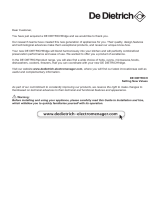
20
TROUBLESHOOTING
Problem: Cause or remedy:
Appliance is connected
to the power mains but it
does not work.
• Make sure there is voltage in the power outlet and that
the appliance is switched on.
Cooling system operates
continuously for a long
period of time:
• Too high environment temperature.
• Door opened too frequently or too long.
• Door not closed correctly (possible impurities on the
seal, misaligned door, damaged seal etc.).
• Too much fresh food inserted at once.
• Insufficient compressor and condenser unit cooling.
Clean the condenser unit.
Excessive build-up of
ice on the back wall of
refrigerator interior can be
a result of the following:
• Door opened too frequently or too long.
• Warm food placed in the refrigerator.
• Food in contact with the back interior wall of the
refrigerator.
• Poor door sealing.
• If the seal is dirty or damaged, clean it or replace it.
Build-up of ice or frost in
the freezer interior may be
a result of the following:
• Door opened too frequently or too long.
• Door not properly closed.
• Poor door sealing.
• If the seal is dirty or damaged, clean or replace it.
Water leaking from the
refrigerator:
• Clogged water discharge opening or water dripping past
the water gutter.
• Clean the clogged opening, for example using a plastic
straw.
• If a thick layer of ice builds up, defrost the appliance
manually (see Defrosting the Appliance).
Door is difficult to open: • If you are trying to open the freezer door after just
having closed it, this could be difficult to do.
As you open the door, some cool air escapes from
the appliance and it is replaced by warm air from the
environment. When this air is cooled, negative pressure is
generated which results in problems as you try to open
the door. After a few minutes, the condition is normalized
and the door can be easily opened again.
524961





















